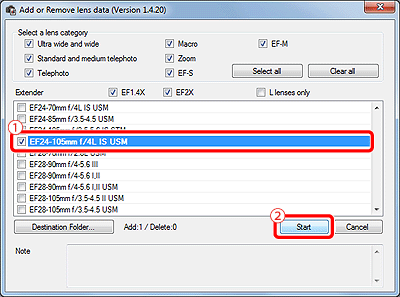Solution
The Digital Lens Optimizer function enables the resolution of images to be increased by removing any remaining aberration related to image-forming capability or any deterioration of resolution resulting from diffraction phenomena. These optical phenomena cannot be corrected under Lens aberration correction. Correction is achieved using the designed value of each lens. The images that can be corrected are RAW images shot using any of the compatible lenses and cameras.
JPEG, TIFF, S-RAW, and M-RAW images cannot be corrected. To use this function, [Lens data] for the lens used to shoot images first needs to be downloaded to your computer. Before using the Digital Lens Optimizer, it is recommended that you set [Sharpness] or [Strength] for [Unsharp mask] for images to 0.
IMPORTANT
- To use this function, an environment with Internet access (subscription to a provider, browser software installed and an in-place line connection) is required.
- An administrator-level privilege is required for this operation.
- Depending on the type, current state, etc. of software running on your computer, the download of the lens data may fail. If it occurs, wait for a while then try downloading the data again.
- Since the lens data downloaded with Digital Photo Professional Ver.3.x is not compatible with Digital Photo Professional Ver.4.x, the lens data must be downloaded again.
Using the Digital Lens Optimizer
1. Start Digital Photo Professional Ver.4.x, then display the RAW image you would like to edit.
2. Display the tool palette, and then switch to the [

] tab.
NOTE
If the tool palette cannot be displayed, select [Tool palette] from the [View] menu on the tool bar.
3. Check the status of [Lens data] for [Digital Lens Optimizer].
・[Not Available]
[Not Available] is displayed for an image shot with a non-compatible camera or lens, or for a non-compatible image such as a JPEG, TIFF, S-RAW, or M-RAW image. The function cannot be used for these images.
・[No]
To use the function, you need to download the lens data for the lens used when shooting the image. It is recommended that you check the lens used when shooting the image beforehand. The lens used can be checked using the image information and shooting information displays. You can also check it with the menu that appears when you right-click with the mouse on an image.
Proceed to step 4.
・[Yes]
Proceed to step 7.
4. Download the lens data.
Click [

] appearing on the left of [Lens data].
NOTE
Before you click the [

] button, Lens data [No] may be displayed instead of [Not Available] for non-compatible images.
5. The [Add or Remove lens data] window appears.
Checkmark the checkbox (

) for the lens used to shoot the image, and click the [Start] button (

).
NOTE
- When you download the lens data, the [User account control] screen may be displayed depending on the computer you use. In this case, please click [Yes].
- If you remove the check mark from the checkbox for already downloaded lens names and click the [Start] button, the lens data will be deleted from your computer.
6. Click [OK] after download of the lens data has finished.
7. Checkmark the [Digital Lens Optimizer] checkbox on the tool palette and adjust the image.
NOTE
When applying the Digital Lens Optimizer, the effect of [Sharpness] or [Unsharp mask] may become excessive. It is recommended that you set [Sharpness] or [Strength] for [Unsharp mask] for images to 0 before using the Digital Lens Optimizer. Adjust [Sharpness] or [Unsharp mask] again after applying the Digital Lens Optimizer to images.
8. Perform adjustments to the items on the tool palette.

: Use the slider to adjust the Digital Lens Optimizer effect.

: Click [

] to revert to the condition before adjustment.
NOTE
Images cannot be corrected for [Chromatic aberration] in the lens aberration correction tool palette if the Digital Lens Optimizer has been applied.
9. In the main window, the [

] mark is displayed on the image to indicate that the Digital Lens Optimizer is applied.
REFERENCE
If you display the [

] tab of the tool palette, you can also adjust the image sharpness. For information on making adjustments, see "Adjusting Image Sharpness" in "Editing with the Basic Adjustment Tool Palette" in the Digital Photo Professional Ver.4.x Instruction Manual.
This concludes the procedure for using the Digital Lens Optimizer in Digital Photo Professional Ver.4.x.
 ] tab.
] tab.



 ] appearing on the left of [Lens data].
] appearing on the left of [Lens data].
 ] button, Lens data [No] may be displayed instead of [Not Available] for non-compatible images.
] button, Lens data [No] may be displayed instead of [Not Available] for non-compatible images. ) for the lens used to shoot the image, and click the [Start] button (
) for the lens used to shoot the image, and click the [Start] button (  ).
).


 : Use the slider to adjust the Digital Lens Optimizer effect.
: Use the slider to adjust the Digital Lens Optimizer effect. : Click [
: Click [  ] to revert to the condition before adjustment.
] to revert to the condition before adjustment.
 ] mark is displayed on the image to indicate that the Digital Lens Optimizer is applied.
] mark is displayed on the image to indicate that the Digital Lens Optimizer is applied.
 ] tab of the tool palette, you can also adjust the image sharpness. For information on making adjustments, see "Adjusting Image Sharpness" in "Editing with the Basic Adjustment Tool Palette" in the Digital Photo Professional Ver.4.x Instruction Manual.
] tab of the tool palette, you can also adjust the image sharpness. For information on making adjustments, see "Adjusting Image Sharpness" in "Editing with the Basic Adjustment Tool Palette" in the Digital Photo Professional Ver.4.x Instruction Manual.